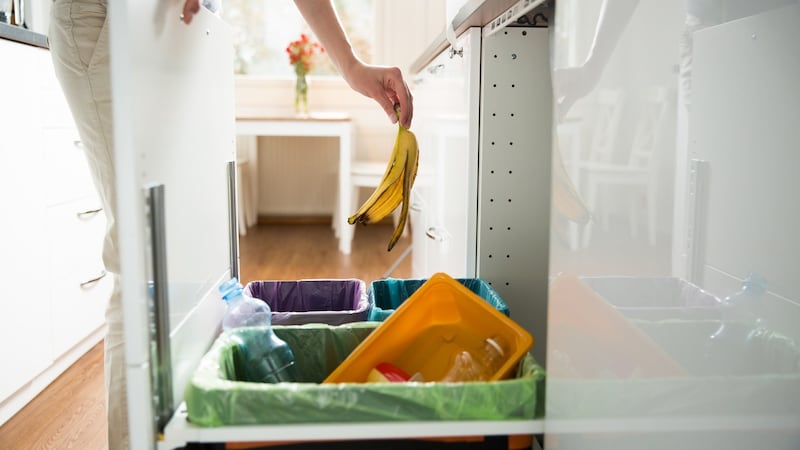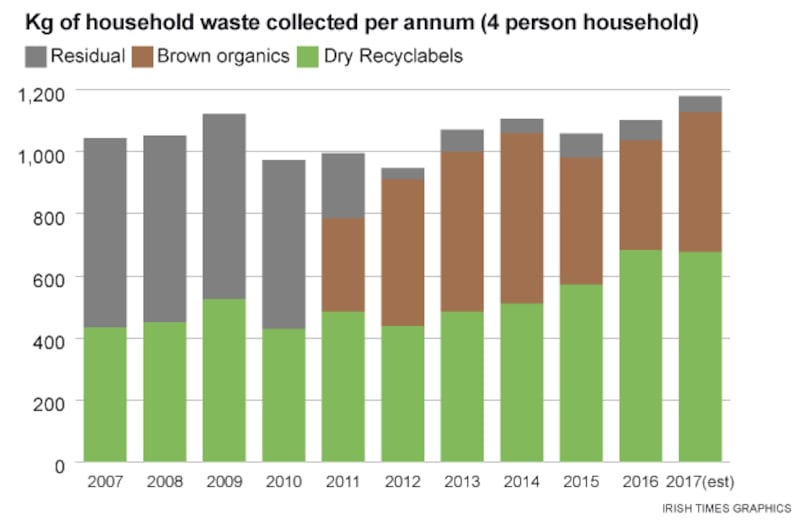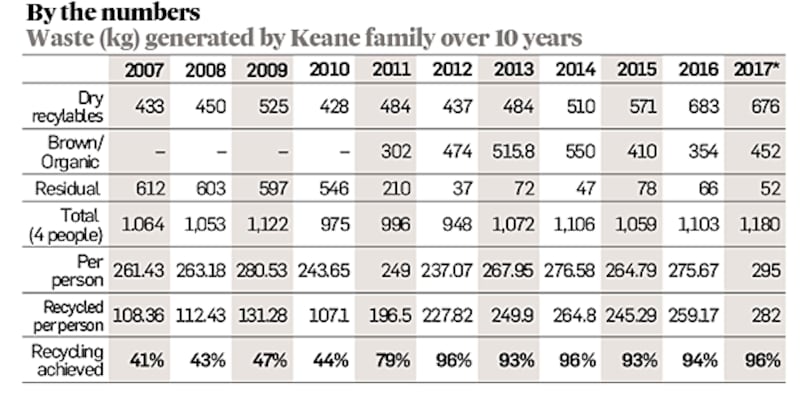If you strawpolled your friends how many of them would be able to tell you what their weight number is? Their waste disposal number that is, the amount of weight their household generates in a calendar year?
It's unlikely any of them would know but one man that does is Brendan Keane. A management consultant in domestic waste company Curland for the last 10 years, he shares a house with his wife and two adult children and produces one tonne of waste per year.
How does he know this? He rang his rubbish collector, Panda, who like most bin collection services weigh your bins regularly – even if you haven’t yet signed up to that method of payment. He explains that there are weight cells in the trucks of most operators and if you ask them they should be able to give you a breakdown of the kilos of waste you use. He then averaged out any gaps.

One tonne, or 1,000 kilos is pretty average, he says. But according to preliminary figures produced by the Environmental Protection Agency for 2014 most adults produce 331 kilos per annum so the Keanes produce 25 per cent less waste than the rest of us.
Waste output
But what’s most interesting about the Keane family waste output is that they produce just 50 kilos of black disposal rubbish per annum. Keane says he only puts his black bin out twice a year. It accounts for just five per cent of the family’s overall annual waste. With weight charges, the more you throw into the black bin the more you will pay.
“Anything food-related gets thrown in the brown bin,” he explains. Fifty per cent of his waste is brown-binned each year – that’s nearly half a tonne of organic waste. But before he tosses a single morsel in, he lines the brown bin with a biodegradable green bin liner.
It prevents the worst of the ferment from polluting the air. Not once has his brown bin been attacked by a fox – an excuse often trotted out by reluctant recyclers. “He has a sniff but he’s not able to get into it,” Keane says. Some bin collection services offer caddy systems; an open caddy for use in the house and a closed (and fox-proof) caddy for outside.
Are waste disposal units that limit the amount of biodegradable rubbish – InSinkerator being the best-known brand – a good investment? Yes, Keane says, "but the waste drains in Ireland are not as wide as they are in the US and in effect you're only passing the problem on to waste and water treatment centres."
Under his sink the bins are divided in to green, brown and black, with the black bin the smallest of the three. “Psychologically, this forces you to think about what you put into it. It’s a tiny black bin,” he explains.
When it comes to the green recycleable bin one of the Keanes is enlisted to jump up and down on its contents regularly to reduce the volume, otherwise it would be “full in a three to four-day period. Rinsing and crushing milk and juice cartons significantly reduces the volume. It makes common sense. Otherwise you’re paying to throw out fresh air.”
Historically Irish families burned much of their waste. Food that wasn’t fed to fowl or domestic pets was incinerated in the range but there was far less food waste than there is now. Burning is no longer an option but the real problem now is that we have become huge consumers, he says, lamenting the fact that “even our dogs and cats no longer eat the leftovers because vets say they shouldn’t be eating human food”.
His advice? “Don’t over-purchase food. Be careful when you shop. Avoid three for two offers – frequently that third one gets thrown out.”
By monitoring food usage and recycling, in 10 years the Keanes have increased the number of kilos each recycles from 108kg per person to 202kg – an average increase of 60 percent and a significant saving for the family.


Do’s and Don’ts
– Make the smallest bin under the sink the black bin. This encourages you to keep it to a minimum.
– Fill the green bin to the top and then have someone jump on it to compact the contents.
– Clean packaging before binning. Someone has to handle this waste so leave it clean enough that you would be happy to handle it yourself.
– Throw glass jars into the dishwasher before you recycle. If you live in Dún Laoghaire -Rathdown you can put glass bottles in the green bin.
– If you have goods delivered to the house by someone who is not a member of Repak you can, by law, ask them to take the packaging back.
– Avoid black polystyrene
– Don’t contaminate the green bin with nappies. It destroys huge levels of packaging. A single nappy can contaminate as much as 10 tonnes of waste that can no longer be recycled.
Waste disposal units
The general thinking is that waste disposal units use a lot of water and are noisy. Environmentalists believe you’re just pushing the waste problem down the pipeline to water services. Prices for an Insinkerator, one of the best known brands, start from about €200. The new and quieter Evolution series starts from about €125 rising to about €550 for the more industrial models.
Zera Food Recycler
The Zera food recycler by Whirlpool is a new device that can turn a week's worth of scraps into fertiliser for your gardener in just 24 hours. But isn't an indoor compost heap pretty pongy and won't it just attract fruit flies? A carbon filter is said to prevent pongs. It launches shortly and can be pre-ordered for about €1100. Zera.com
Box Clever
Weareobeo is a compostable box you can buy in supermarkets. Made of breathable fibres and water-resistant paper it stays intact and is designed to sit on your counter. Because it is certified compostable and biodegradable it can be put straight into the brown bin. It won't leak smelly liquid into the bin or onto the street. You can buy at most supermarkets or online where you can bulk buy 30 boxes for €27. Weareobeo.com












